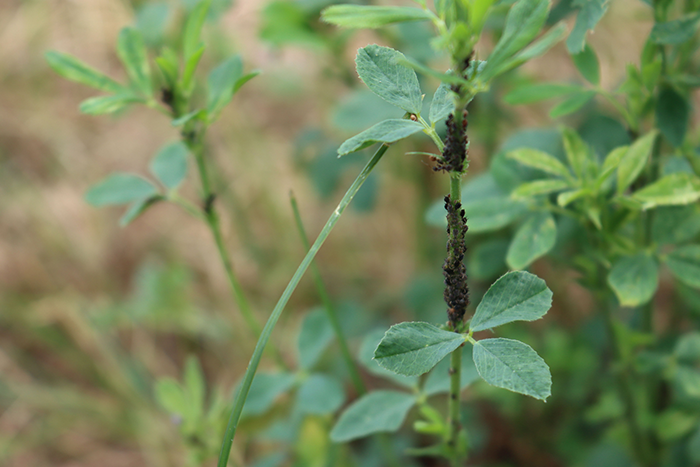
Aphids are a bane in alfalfa fields, especially considering the rapid rate of reproduction and range of toxicity among the species. Damage from aphids feeding on plant sap as well as their injection of toxic saliva into plant tissues can result in significant yield loss and an overall reduction in plant vigor.
“Knowing how to recognize aphids and their damage and understanding their treatment thresholds is important for making proper management decision,” says Anthony Zukoff, an extension entomology associate with Kansas State University.
From a distance, aphid damage can appear as yellow or distorted leaves and stunted plant growth; however, scouting stands by getting an up-close look at alfalfa will be necessary to determine when pest populations reach economic thresholds. Zukoff describes as much for the four types of aphids found in alfalfa — pea aphids, blue alfalfa aphids, cowpea aphids, and spotted alfalfa aphids.
Pea aphids
Pea aphids are large and easy to spot in the adult stage. They are typically light green and shiny, with long legs and black-tipped cornicles. Zukoff notes a defining feature between the pea aphid and the similar blue alfalfa aphid is the former’s antennae, which have narrow, dark bands on each segment and light-colored tips.
Economic thresholds for pea aphids vary with alfalfa maturity. For example, Zukoff suggests 50 pea aphids per stem is the cut off for plants that are 10 inches tall, whereas 100 pea aphids per stem is the threshold for 20-inch-tall alfalfa.
Blue alfalfa aphid
Like the pea aphid, the blue alfalfa aphid is also light green in color, although it has a more waxy, blue-green appearance. Another difference between the two is blue alfalfa aphids’ antennae are a solid dark color, not banded. Blue alfalfa aphids are also smaller than pea aphids, yet the former pest can be more damaging, producing a more potent toxin that stunts plants and reduces forage yield to a greater degree.
For this reason, economic thresholds for blue alfalfa aphids are more sensitive than those for pea aphids: 20 insects per stem on 10-inch alfalfa and 50 insects per stem on 20-inch alfalfa.
Cowpea aphids
Zukoff suggests cowpea aphids are easiest to identify as adults have dark-colored, round bodies and white legs. Nymphs are also an easily identified blue-gray color, though smaller than adults. Moreover, cowpea aphids tend to feed on stem tips, making them easier to spot. According to Zukoff, economic thresholds for cowpea aphids are similar to those for pea aphids.
Spotted alfalfa aphid
This type of aphid gets its name from the distinct rows of dark spots against its translucent, white to pale yellow body. Zukoff notes economic thresholds for these pests are quite low for young alfalfa plants.
Alfalfa that is 2 to 3 inches tall can only tolerate four to five spotted alfalfa aphids per plant, Zukoff states. On the other hand, the economic threshold for alfalfa that is 10 inches tall is about 50 insects per stem, and 20-inch-tall alfalfa can tolerate more than 100 aphids per stem.
“Note the relatively large thresholds for some of these aphids,” Zukoff advises. “It is important to scout properly so you don’t make unnecessary treatments. Aphid populations can be a good thing by promoting the presence of various beneficial insects that can help suppress aphid populations and other potential pests. Consider the presence and density of beneficials when making treatment decisions,” he adds.

